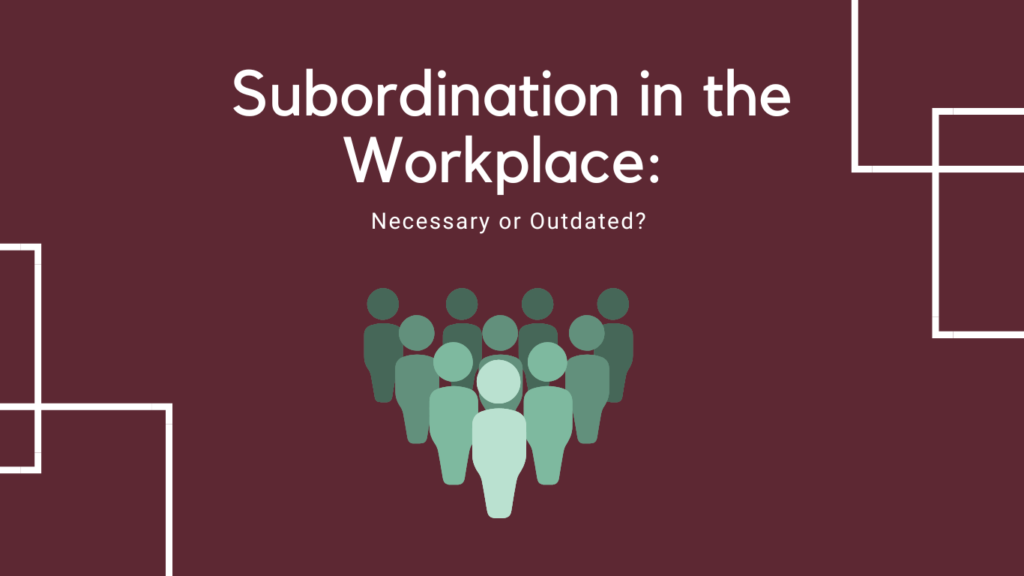Subordination in the Workplace. Is it Necessary or is it Outdated?

There is a great deal of debate surrounding the concept of workplace subordination. Some people believe that it is a necessary part of the workplace hierarchy, while others feel that it is no longer relevant in today’s society. Yet, if it is not that important, why are we still talking about it?
The answer may lie in the fact that subordination, while it may not be as relevant as it once was, can still have a significant impact on workplace dynamics. And, more importantly, about the consequences for employees who do not comply with workplace subordination rules. If you want to know the answer to this dilemma, stay tuned as we are telling you everything about it!

Relationships Dynamics Within The Workplace
If we look at our workplace it holds some sort of “hidden” dynamic that makes everything work, and we can slightly call that energy subordination. It is an unspoken rule in which everyone knows their place, and what they can and cannot do. This way of working has been around for centuries, and it is not likely to change anytime soon.
However, some argue that workplace subordination is outdated and no longer relevant in today’s society. After all, we are now living in a world where more and more people are working remotely, and the traditional hierarchical workplace structure is no longer as prevalent.
Let’s dive into the topic, shall we?
What Is a Subordinate-Supervisor Relationship in the Workplace?
Subordination at work essentially refers to the workplace hierarchy. It is the relationship between an employee and their supervisor, or between different employees who have different levels of authority within the company.
The company’s organizational structure usually determines this relationship
Workplace subordination can take many different forms. It can be as simple as an employee following the orders of their supervisor, or it can be more complex, such as an employee deferring to a colleague with more experience or knowledge. In some cases, workplace subordination may even involve employees being required to complete tasks that are outside of their job descriptions.
Au contraire… Insubordination in the workplace is defined as a willful disregard for the legitimate authority of those in charge. It occurs when an employee deliberately fails to comply with workplace rules or ignores direct orders from their supervisor.

While workplace subordination is not always a bad thing, it can sometimes lead to conflict and tension within the workplace. This is especially true if employees feel that they are being mistreated or that their work is not valued. Additionally, workplace subordination can also create an environment where employees are afraid to speak up or challenge authority.
Yet, this could be a result of workplace toxic culture, and not exactly about subordination being bad. In fact, workplace subordination can actually be beneficial for both employees and employers. For example, workplace subordination can help to ensure that tasks are completed in a timely and efficient manner!
Let’s take a look at the pros and cons of this type of hierarchical structure.
Get more out of your business
Get the best employee engagement content every week via mailing list
The Pros of Workplace Subordination
A well-functioning workplace subordination system can actually have several benefits for both employees and employers.
Some of the advantages of workplace subordination include:
Allows for Clear Lines of Authority
One of the main advantages of workplace subordination is that it provides clear lines of authority. This clear chain of command can help to ensure that tasks are completed efficiently and effectively. In most cases, it is fairly easy to determine who an employee should go to with questions or concerns. Additionally, clear lines of authority can also help to prevent conflict within the workplace.
Ensures that Tasks are Completed
Another benefit of workplace subordination is that it helps to ensure that tasks are completed in a timely manner. This is because employees are typically required to complete tasks that are assigned to them by their supervisors. Additionally, workplace subordination can also help to motivate employees to work harder and meet deadlines.
Eliminates the Need for Micromanagement
Evidently, when you have a system in place to get every task done, you avoid having to chase your staff for efficiency. Workplace subordination can eliminate the need for micromanagement. This is especially important considering 79% of employees had experienced micromanagement and 71% said micromanagement interfered with their job performance.
Easier to Implement Work Policies
Workplace subordination can also make it easier for employers to implement workplace policies. This is because employees are typically required to follow the rules and regulations set forth by their supervisors. Additionally, workplace subordination can help to ensure that employees are held accountable for their actions.
Efficient Communication
Workplace subordination can also help to ensure that communication is clear and concise. This is because employees are typically required to follow a specific chain of command when communicating with their supervisors. Additionally, this type of hierarchical structure can also help to prevent miscommunication within the workplace.
Easier to Train and Supervise
Another advantage of workplace subordination is that it can make training and supervision easier. This is because employees are typically only responsible for completing tasks that are within their job descriptions.
This can be a major benefit for employers, as it can save time and resources that would otherwise be spent on training employees. Additionally, it can also help to improve the quality of work within the workplace.
The Cons of Workplace Subordination
When used correctly, workplace subordination can help employees to feel empowered and motivated. It can also help to ensure that tasks are completed efficiently and effectively. However, it is important to note that workplace subordination can also have several disadvantages.
Cumbersome Bureaucracy
One of the main disadvantages of workplace subordination is that it can lead to cumbersome bureaucracy. This is because hierarchically structured workplaces often have a lot of rules and regulations. Additionally, it can also lead to a lack of creativity within the workplace.
Rigid Workplace Structure
Another disadvantage of workplace subordination is that it can create a rigid workplace structure. This type of hierarchical structure can often make it difficult for employees to express their opinions or ideas, making it difficult for employees to be promoted.
Consequently, this can make it difficult for employers to be flexible with their employees. Additionally, it can also lead to a lack of collaboration within the workplace.
Lack of Employee Empowerment
Not only does empowerment encourage team engagement, but it also boosts productivity. According to research, just 4% of employees are ready to put in more effort when empowerment is low, but 67% are prepared to do so when empowerment is high.
One of the main disadvantages of workplace subordination is that it can often lead to a lack of said empowerment. This is because subordinate employees are often not given the same opportunities or resources as their superiors, which can often lead to a feeling of powerlessness and frustration amongst employees.
Can Lead to Conflict
As we mentioned before, one of the main disadvantages of workplace subordination is that it can sometimes lead to conflict within the workplace. This is because employees may feel that they are being mistreated or that their work is not valued. Additionally, workplace subordination can also create an environment where employees are afraid to speak up or challenge authority.
Can Be Unmotivating
Another downside of workplace subordination is that it can be unmotivating for some employees. This is because they may feel like they are not being allowed to show their skills and abilities. Additionally, some employees may feel like they are not being given the chance to advance in their careers.
When reading this, we can think the matter of whether subordination is outdated or not resides in when and how to implement subordination!
How to Implement Healthy Subordination At Work?
Telling your employees what to do all the time is not a good way to get their creative juices flowing. If you need subordination at work, there are more effective ways of going about it than micromanaging every task.
Here are a few tips on how to implement healthy subordination:
It’s Hierarchy, Not a Tyranny
Bureaucracy and red tape are often the by-products of an unhealthy hierarchy at work. If you want to implement healthy subordination, make sure that your workplace hierarchy is not a tyranny. Employees should feel like they have a voice and that their opinions are valued.
Encourage Open Communication
One of the key ingredients of healthy subordination is open communication. Employees should feel like they can openly communicate with their superiors without fear of reprisal. Additionally, superiors should also make an effort to listen to their subordinates.
Encourage Creativity and Innovation
As we mentioned before, one of the main disadvantages of workplace subordination is that it can lead to a lack of creativity within the workplace. To encourage creativity and innovation, try to create an environment where employees feel like they can freely express their ideas. Additionally, try to provide opportunities for employees to showcase their skills and abilities.
Encourage creativity, even if it means challenging the status quo!
Don’t Be the “Toxic” Boss
We’ve all had a “toxic” boss at some point in our careers. This is the kind of boss who micromanages every task, is always looking for someone to blame, and creates a general feeling of unease within the workplace. If you want to implement healthy subordination, make sure that you’re not the “toxic” boss.
A “toxic” boss is someone who uses their position of power to mistreat or take advantage of their subordinates
This type of behavior can foster a feeling of fear and mistrust amongst employees, which is not conducive to a healthy work environment. Blaming your subordinates for your own mistakes is also a surefire way to breed resentment. If you want to be a good boss, take responsibility for your shortcomings.
Blaming and Criticizing
Blaming your subordinates for your own mistakes is not only unprofessional, but it’s also a surefire way to breed resentment. On the other hand, constructively criticizing your subordinates can help them improve their performance.
Avoid blaming and criticizing your employees if something goes wrong. Instead, focus on finding solutions together. If you want to be a good leader, learn to distinguish between blaming and criticizing.
Be Transparent
Trying to hide things from your subordinates will only breed mistrust. If you want to implement healthy subordination, make sure that you’re being transparent with your employees. This means being honest about both the good and the bad.
Let your employees know what’s going on in the company. Transparency is key to healthy subordination. Employees should know why decisions are being made and how they will affect them.
Treating Employees With Respect
Treating your employees with respect is one of the most important aspects of healthy subordination. Remember, your employees are human beings, not machines. They have feelings and needs just like you do.
If you want to create a healthy work environment, make sure that you’re treating your employees with the respect they deserve, valuing their opinions, listening to them, and making an effort to see things from their perspective. It also means providing them with the resources they need to do their jobs effectively.
Trust Your Employees
One of the most important aspects of healthy subordination is trust. If you want your employees to trust you, you need to trust them first. This means delegating tasks and allowing them to shine. It also means not micromanaging every aspect of their work.
If you want to build trust within your team, you need to let go of the reins and allow your employees to show you what they’re capable of. Creating a healthy work environment starts with you!
Takeaway
Workplace subordination can be a necessary and beneficial tool when used correctly. However, it is important to note that it can also have several disadvantages. As such, it is important to carefully consider whether or not workplace subordination is right for your business.
If you do decide to implement workplace subordination, it is important to do so in a way that minimizes the potential for conflict and maximizes employee empowerment. By following the tips we’ve outlined above, you can create a healthy work environment where employees feel valued and respected.
If you found our blog post educational, don’t hesitate to explore our archive. We got a bunch of good articles just for you!
-The Monitask Team


